Abstract
Polar staining (PS) of Toxoplasma gondii in the indirect immunofluorescence test has been considered a nonspecific reaction caused exclusively by certain immunoglobulin M (IgM) antibodies and confined to the anterior end of the parasite. After we observed a patient with positive serology for Chagas' disease who presented an IgG PS reaction, we studied sera from 120 patients with Chagas' disease, 20 sera from patients with Leishmania donovani infection, and 30 sera from patients with Leishmania braziliensis infection. When only those specimens having no detectable anti-Toxoplasma activity were considered, a significantly (P less than 0.01) higher prevalence of IgG PS was found in the Chagas' disease and L. donovani groups than in sera from normal American and Brazilian adults. Those sera also showed higher PS titers (1:64 to 1:1,024) when compared with controls (1:16 to 1:64). IgG PS titers did not decrease after serum treatment with 2-mercaptoethanol. However, the same treatment removed completely IgM PS. IgG PS, but not IgM PS, could be removed by adsorption with Trypanosoma cruzi epimastigotes. IgM PS was found in all samples studied, except in 41 of a group of 43 umbilical cord sera. It was found that the antigen source and the microscopy system can influence the detection of PS. It is proposed that after finding an intense IgG PS reaction, the laboratory should screen such serum also for anti-T. cruzi antibodies which may be undetected in the sample.
Full text
PDF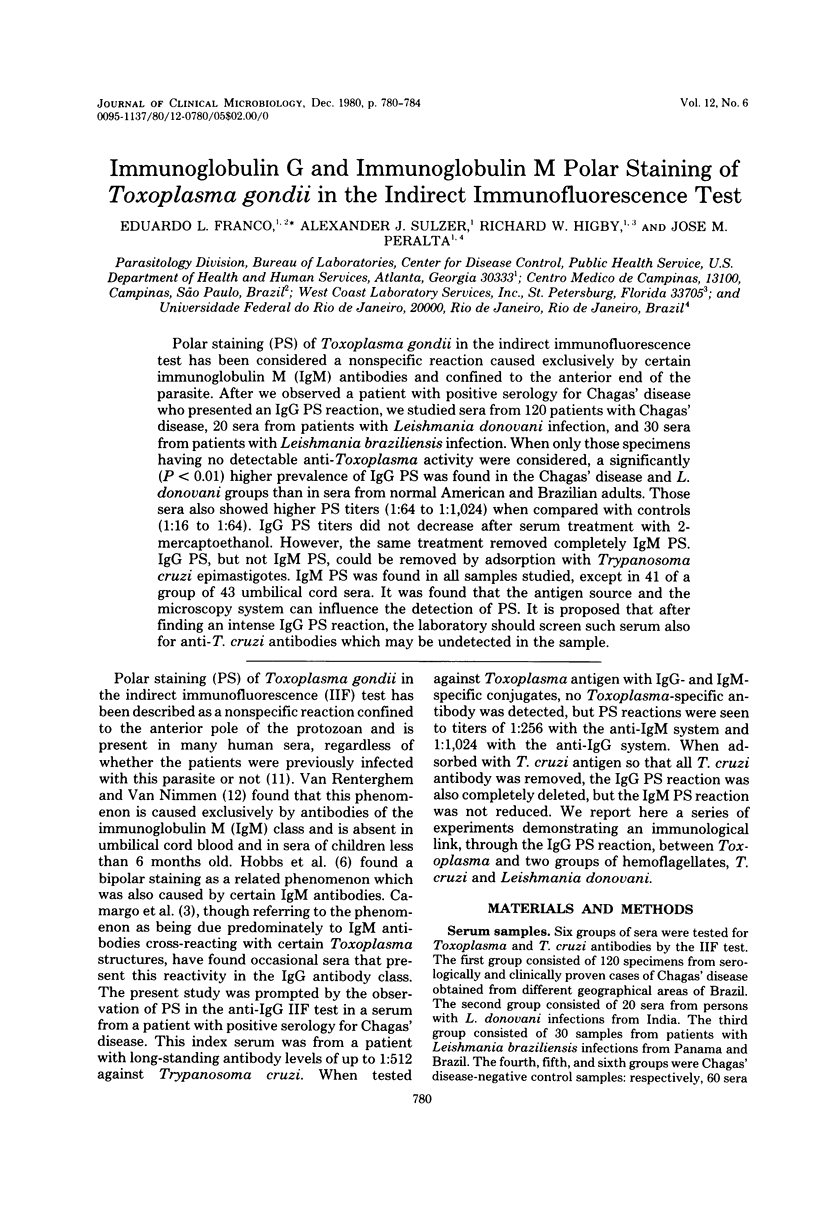
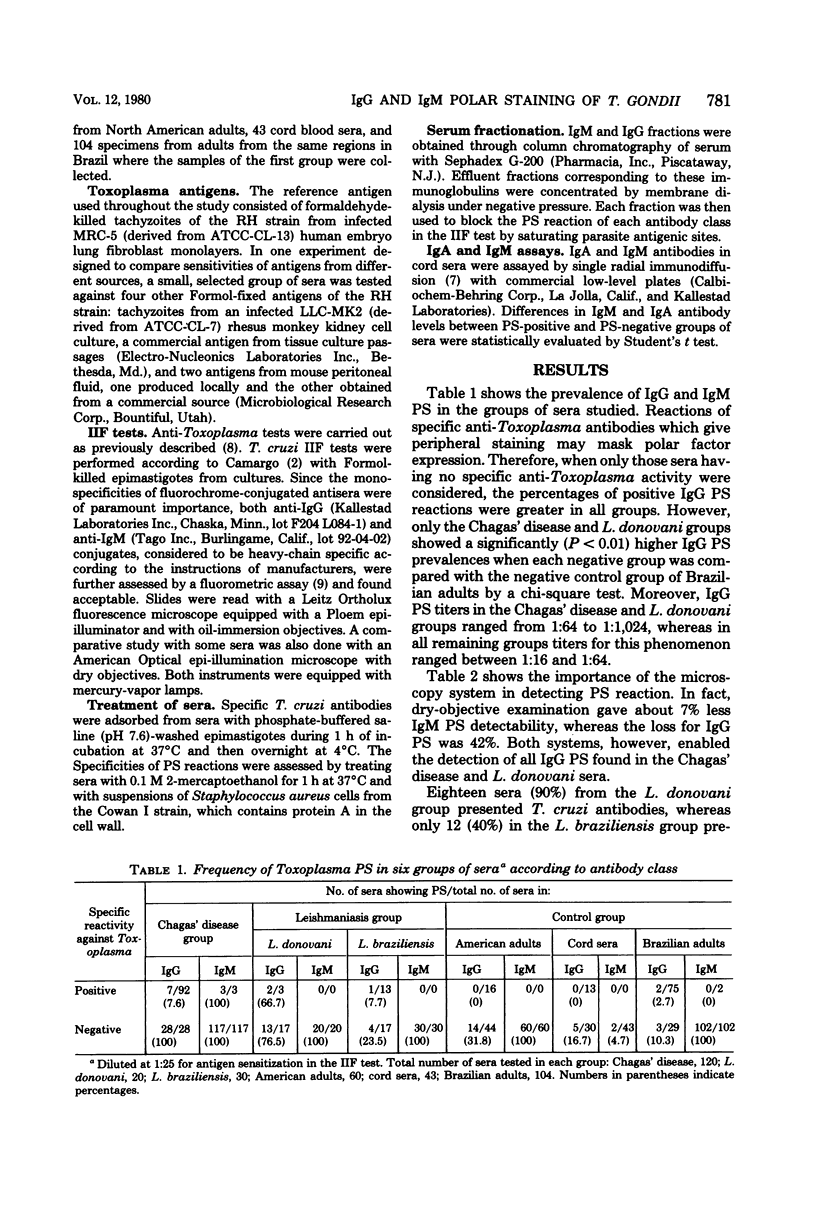
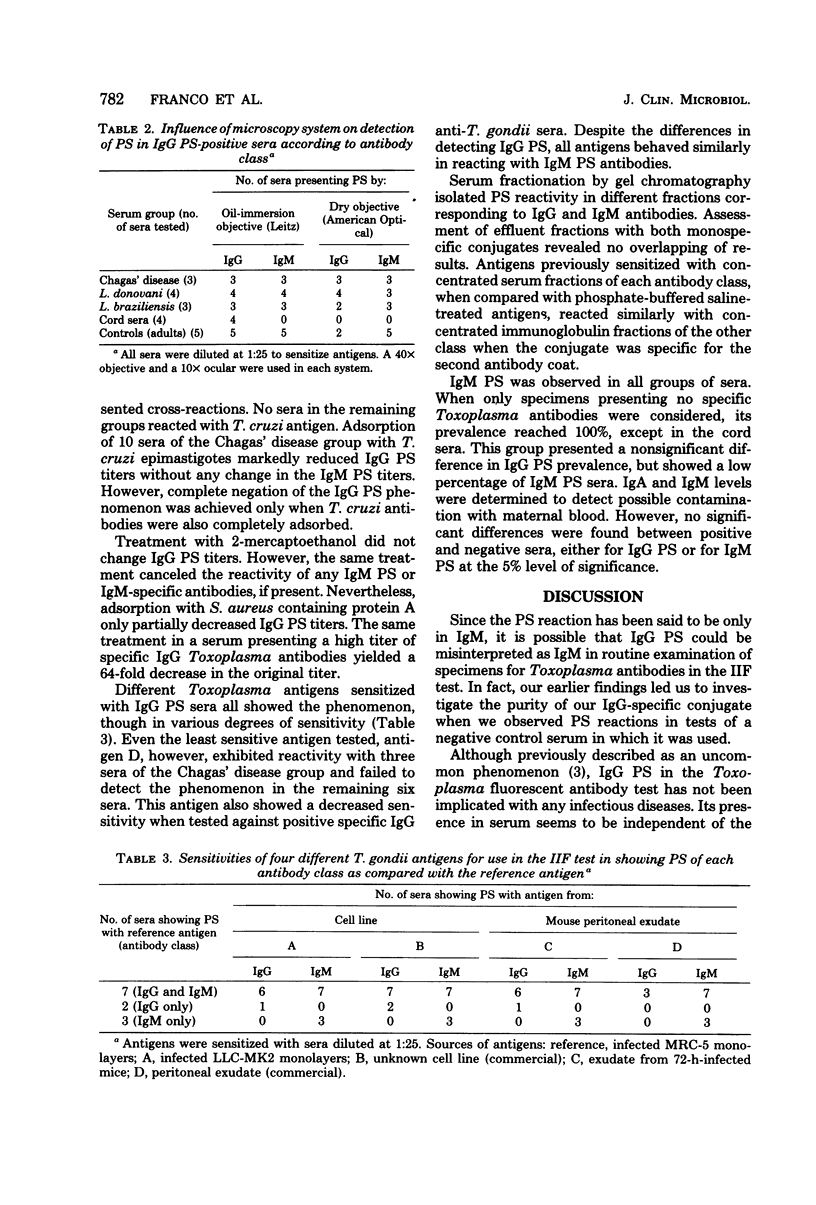
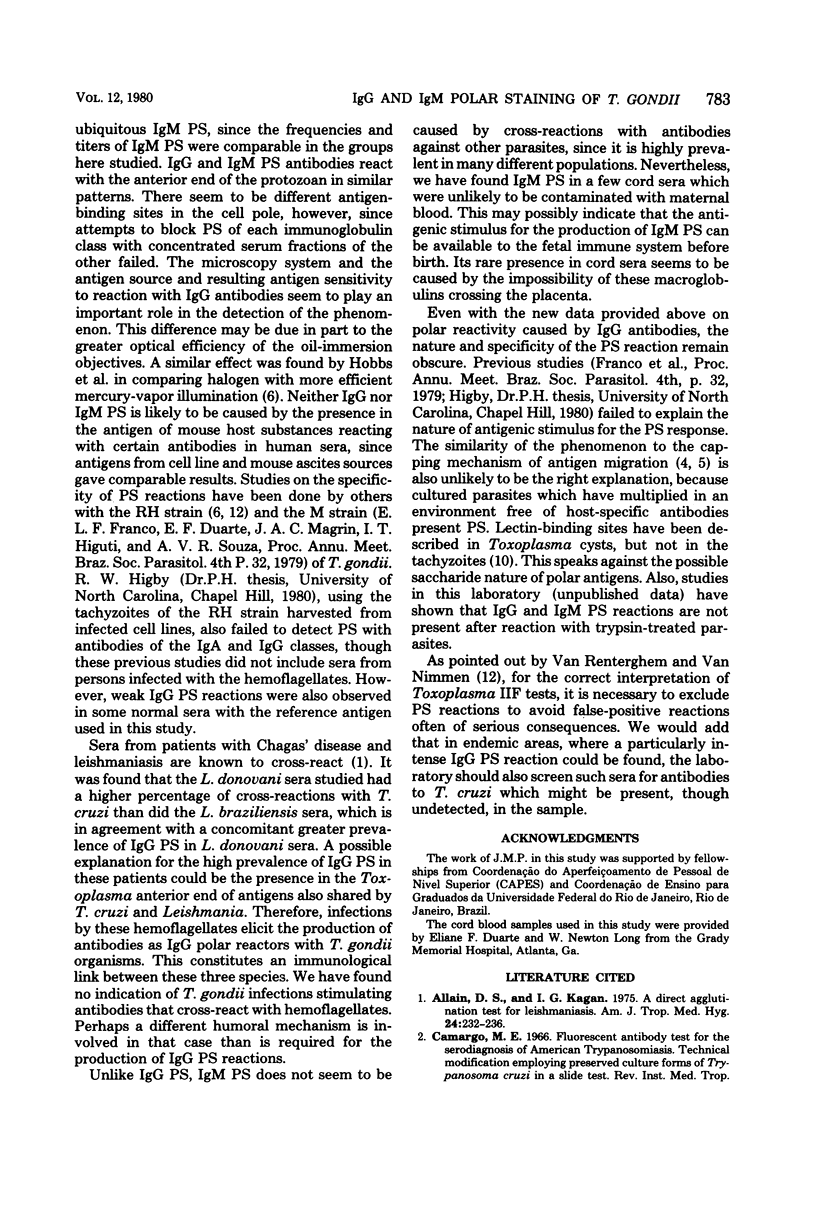
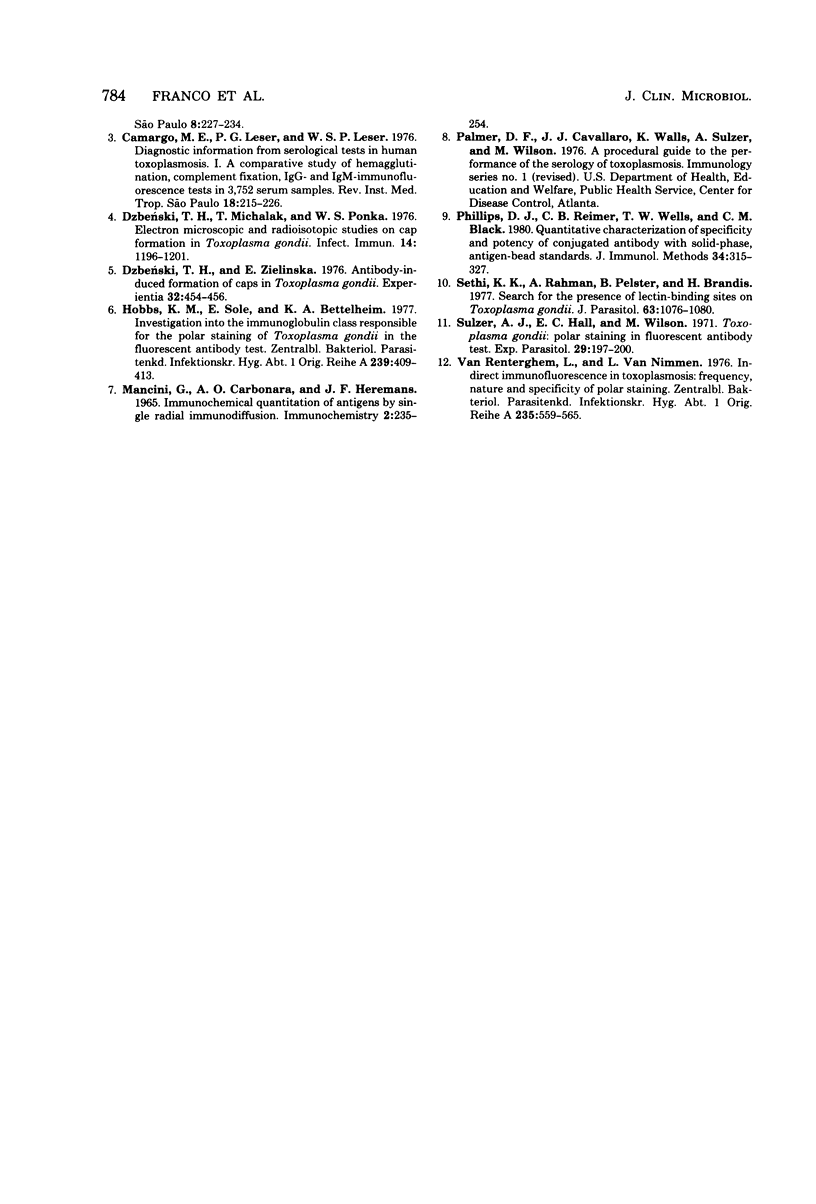
Selected References
These references are in PubMed. This may not be the complete list of references from this article.
- Allain D. S., Kagan I. G. A direct agglutination test for leishmaniasis. Am J Trop Med Hyg. 1975 Mar;24(2):232–236. doi: 10.4269/ajtmh.1975.24.232. [DOI] [PubMed] [Google Scholar]
- Camargo M. E., Leser P. G., Leser W. S. Diagnostic information from serological tests in human toxoplasmosis. I. A comparative study of hemagglutination, complement fixation, IgG and IgM-immunofluorescence tests in 3,752 serum samples. Rev Inst Med Trop Sao Paulo. 1976 Jul-Aug;18(4):215–226. [PubMed] [Google Scholar]
- Dzbenski T. H., Michalak T., Plonka W. S. Electron microscopic and radioisotopic studies on cap formation in Toxoplasma gondii. Infect Immun. 1976 Nov;14(5):1196–1201. doi: 10.1128/iai.14.5.1196-1201.1976. [DOI] [PMC free article] [PubMed] [Google Scholar]
- Dzbeński T. H., Zielińska E. Antibody-induced formation of caps in Toxoplasma gondii. Experientia. 1976 Apr 15;32(4):454–456. doi: 10.1007/BF01920792. [DOI] [PubMed] [Google Scholar]
- Hobbs K. M., Sole E., Bettelheim K. A. Investigation into the immunoglobulin class responsible for the polar staining of Toxoplasma gondii in the fluorescent antibody test. Zentralbl Bakteriol Orig A. 1977 Nov;239(3):409–413. [PubMed] [Google Scholar]
- Mancini G., Carbonara A. O., Heremans J. F. Immunochemical quantitation of antigens by single radial immunodiffusion. Immunochemistry. 1965 Sep;2(3):235–254. doi: 10.1016/0019-2791(65)90004-2. [DOI] [PubMed] [Google Scholar]
- Phillips D. J., Reimer C. B., Wells T. W., Black C. M. Quantitative characterization of specificity and potency of conjugated antibody with solid-phase, antigen bead standards. J Immunol Methods. 1980;34(4):315–327. doi: 10.1016/0022-1759(80)90104-0. [DOI] [PubMed] [Google Scholar]
- Sethi K. K., Rahman A., Pelster B., Brandis H. Search for the presence of lectin-binding sites on Toxoplasma gondii. J Parasitol. 1977 Dec;63(6):1076–1080. [PubMed] [Google Scholar]
- Sulzer A. J., Wilson M., Hall E. C. Toxoplasma gondii: polar staining in fluorescent antibody test. Exp Parasitol. 1971 Apr;29(2):197–200. doi: 10.1016/0014-4894(71)90024-5. [DOI] [PubMed] [Google Scholar]
- van Renterghem L., van Nimmen L. Indirect immunofluorescence in toxoplasmosis: frequency, nature and specificity of polar staining. Zentralbl Bakteriol Orig A. 1976 Aug;235(4):559–565. [PubMed] [Google Scholar]


